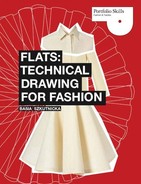ADDING COLOR, TEXTURE, AND PATTERNS TO FLATS
Once you have completed your technical drawings, including all the detailing, they may then be rendered to show the color, texture, or pattern of the fabric or material if required, and these embellished drawings are known as "floats." Technical drawings are usually left unrendered when used on design development sheets, presentation sheets, spec sheets, costing sheets, pattern books, price lists, and look books, but may be rendered on line boards, or when it is necessary to show such detail as different colorways, fabrics, or textures, for example. Coloring-up is usually undertaken in Photoshop.
BLOCK COLOR
Most coloring-up will involve the application of block color.
STEP 1
You can either scan in a hand-drawn flat or work from a drawing created in Illustrator. Whichever route you choose, the drawing should be imported in to Photoshop.

STEP 2
Select the panels you wish to color-up and use the Paint Bucket Tool to add color.


HINTS & TIPS
If you have a complicated garment—one with lots of gathers, for example, it can be more difficult to color-up, as the Paint Bucket Tool may not fill in all of the individual pixels (see below and below left, close-up detail).
In this case you can either use the Paint Bucket Tool or Pencil Tool to fill in the color.




Alternatively, you can fill a selection with a background color by holding down the Apple/Control key and pressing the Backspace key. To fill with a foreground color, hold down the Alt key and press Backspace. This will fill the entire block without the need to color in pixels individually.
PATTERN
When applying print or pattern to a style, pay attention to where the seams and gathers are, as these will cause a break in the pattern. Do not simply lay a pattern flat over a garment, as it would not look this way in real life. You also need to consider the scale of your print pattern to ensure an accurate representation.
TEXTURE
Unless the texture of a fabric is very different (fake fur, for example), the drawing will stay the same. Texture will occasionally vary the line of a technical drawing, as seen in the example below: the style is shown as though it were made in a simple cotton (left), and then in a short-pile fake-fur fabric (right).



